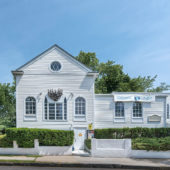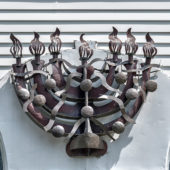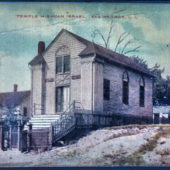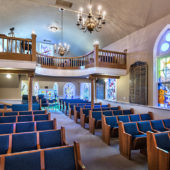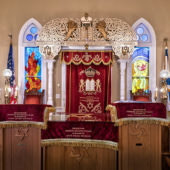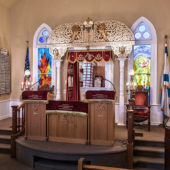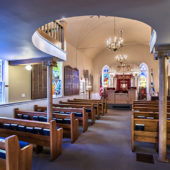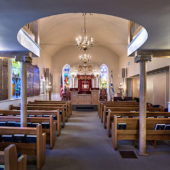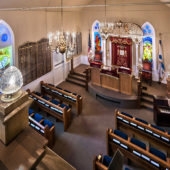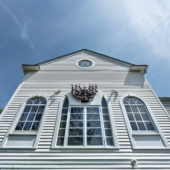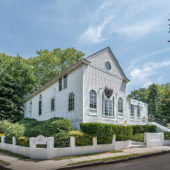Long Island’s oldest synagogue
Quoted from the booklet prepared for Temple Adas Israel’s 120th Anniversary:
Temple Adas Israel is a synagogue founded 120 years ago in Sag Harbor, New York-the cornerstone of Jewish religious and cultural life on Long Island’s East End. From its early days as Temple Mishcan Israel, Temple Adas Israel has been the focal point of the Jewish experience. We devote and pay tribute in celebrating its 120th anniversary his year on June 26, 2016.
The history of the Temple illustrates the Jewish immigrant experience in the United States some 150 years ago when early Sag Harbor immigrants formed mutual benefit societies, founded cemeteries and built this synagogue as they redefined their religious needs in the new world they were 10w inhabiting.
Our Jewish history in Sag Harbor first came to prominence during the Revolutionary War when Jews loyal to the American Cause abandoned their homes and properties rather than live under British rule. Merchant, ship owner and part owner of Sag Harbor wharf, Aaron Saacs was among those who fled to Connecticut when Long Island came under English control. Jewish merchants mortgaged their property close to $150,000 to underwrite the Revolutionary army.
Legend has it that Temple Mishkan Israel was given its first Tor ah by Theodore Roosevelt. According to the story, Roosevelt acquired the Torah in 1898 when he returned to the U.S. with the 1,200 Rough Riders he had led in the charge up San Juan Hill during the Spanish-American War. When three of his men contracted yellow fever, Roosevelt returned to American shores via Montauk. The brigade was quarantined for a month to assure no one else caught the contagious disease. During their stay in Montauk the men held worship services, including Shabbat services for the Jewish soldiers. A Torah was procured for this purpose. When the brigade left, after the quarantine period, Roosevelt donated the Torah to the nearest synagogue: Temple Mishcan lsrael in Sag Harbor. He and his troops then went on to a hero’s welcome in Manhattan. Like the vast majority of other Jewish immigrants, Sag Harbor’s early Jews established a toe-hold in the community, formed mutual benefit societies, founded a cemetery, and as their numbers grew, built a synagogue. They also struggled to redefine Jewish family life in a new world. In some respects, however, Sag Harbor’s Jewish history is unique. It is the story of Jewish immigrants, attracted by the opportunity and availability of work, choosing life in a small village over the more common urban experience.
In 1847 there were only 50,000 Jews in the United States (one quarter of one percent of the entire population). Fifteen thousand of them lived in New York City. It took Sag Harbor another 40 years and the relocation of a watchcase factory from New Jersey before a Jewish community appeared. Sag Harbor was once a thriving commercial center, but reverted to a sleepy rural village in the mid-19th century. By 1850, with the demise of its whaling industry, the town was searching for an economic base that would return it to prosperity. In the early 1880’s, Joseph Fahys, a watchcase manufacturer, was convinced by local businessmen and town officials to move his factory from Carlstadt, New Jersey, to Sag Harbor- bringing hundreds of desperately needed jobs to the struggling community. From this new location he could easily ship his products to New York City via the newly-opened Long Island Railroad. Fahys built the brick factory that is currently being converted into condominiums on Washington Street. At the same time, additional manufacturing and commercial structures, as well as workers’ residences, were built on the nearby streets and alley ways. Shortly thereafter, shops on Main Street and houses on South and Suffolk Streets emerged. Like many American factory owners, Fahys relied on immigrant labor, including Russian, Polish and Hungarian Jews. According to the 1900 Sag Harbor census, approximately 100 Jewish men worked in the factory. In those early years, the struggle for a livelihood overshadowed any other human need. Tradition teaches us that “Without bread there can be no Torah.” In 1889, the death of a child created a concern for spiritual matters. There was no Jewish cemetery east of Lindenhurst ( where a corner of a Protestant cemetery, had to be set aside for Jews).
The Sag Harbor Jews organized a Jewish Cemetery Society. An initiation fee of 25 cents, with weekly dues of 5 cents, was levied on all members. In 1890 they purchased land for $50 and cleared it themselves. This marked the beginning of Jewish spiritual life in the area. The cemetery, which is still located on Route 114 between Sag Harbor and East Hampton, is now run by the Chevra Kodetia Society of Temple Adas Israel. Once they were organized to serve their religious needs, they decided to build a synagogue. This required increasing their weekly dues to 10 cents. In 1896, Nissan Meyerson purchased the property where the synagogue now stands, for $350. The Temple built, at a cost of $2,500, combined the architectural form of a wooden Colonial Church and an Eastern European synagogue. The first services in the building were held in 1898 to celebrate Rosh Hashanah.
The exterior of the Temple was painted white; it had a peaked roof and two plain white pillars that stood on either side of the entrance door. Unlike a church, “there is no cupola, steeple or bell on the tabernacle … and long Gothic windows with colored stained glass panels let in abundant light,” according to an article in The Brooklyn Eagle. Inside, in European tradition, there were two altars: one in the center of the synagogue where the rabbi and cantor read the Torah scroll; another at the East wall facing Jerusalem, containing the Ark, the Eternal Light and the Tablets of the Commandments. The seating capacity in the main sanctuary was 100; and since the Temple was originally Orthodox and women were not permitted to worship with men – a “Ladies Gallery, with its own exterior entrance, was built with additional seating for 60.” The basement contained a mikvah, a baptismal font used by Orthodox Jewish women for purposes of ritual cleanliness, as in the ceremony of conversion of a Gentile to Judaism. There was also an apartment for a janitor later used by resident and itinerant rabbis. At that time there were about 50 member families. Formal dedication ceremonies were held October 28, 1900, and according to an article describing the event in the following day’s Brooklyn Daily Eagle, “A severe rainstorm set in just before the service, but in spite of the rain the church was packed.” Religious services were held weekly on Fridays and Saturdays with the officers wearing robes and solid gold medals.
Since there were very few ordained rabbis during this period, landsmanshaftn (mutual aid societies) provided rabbinical services, along with their other duties. Temple Mishcan Israel was one of the beneficiaries of this movement. The lay “rabbis” would journey from New York City to Sag Harbor and other East End towns, where they were housed in comfort by Temple members in exchange for leading Shabbat services and other traditional observances. Temple Mishcan Israel attracted Jews to Sag Harbor from towns all over the East End, a pattern that continued until the 1960s. The 1920s marked both the beginning of economic decline in Sag Harbor and the decline of Temple Mishcan Israel. New laws restricted immigration and set rigid quotas on the number of Jews and other Southern and Eastern Europeans from entering the United States, thus ending decades of new Jewish settlement. These restrictions were favored by many elite families and descendants of Colonial settlers who felt their way of life was threatened by the new ethnic groups. In 1925, another crisis hit the townspeople of Sag Harbor: a major fire consumed large portions of the Fahys Watchcase Factory and the Alvin Silver Factory. It forced both operations to lay off hundreds of workers and cease reduction. Because of these incedents, the Jewish population Sag Harbor dwindled to fewer 1an a dozen families. Despite the decline in population during the depression, most of Sag Harbor’s Jewish businesses survived. However, there was a catastrophic effect on the Temple. There was no money to pay a visiting rabbi, and the structure began to deteriorate. The mikvah fell into disuse, and was finally boarded up in the early 1940s, not be seen again until it was accidentally discovered 1 1977. Also in the early 1940s, the Temple – severely impacted, by long term population and economic decline – was open only for the High Holy Days. Although Jewish-owned stores still dominated Sag Harbor’s Main Street, only a few Jews attended services. A big change came in 1948, when the Temple abandoned its Orthodox roots, and became Conservative, with a new name: Temple Adas Israel. After World War II, young professionals, artists and writers moved to the East End, searching for a cultural and economic environment conducive to their creative energies and ideals. So by 1950, Sag Harbor’s Temple Adas Israel was once again a center of Jewish life. Shabbat services were held on Thursdays, since the visiting rabbis had to tend to their own congregations on Fridays and Saturdays. A Sunday school, taught by Temple members, was begun and attracted many children from surrounding towns. Although still without a full-time rabbinic presence, the Temple underwent extensive renovations, thanks to successful fundraising by the area’s Jews and sympathetic Christians alike. In 1956, the Temple acquired an adjacent lot for $1,500.00. Today it is the Social Hall and “expanded” sanctuary during the High Holy Days. Long-time member Dave Lee recalls: “Back in the 1950s, I was outside the Temple fixing a window on the Eastern wall of the shul and I got into a conversation with the owner of the overgrown and undeveloped empty lot next door. His name was Philip Harboy. While our conversation was of a general nature, I thought I would plant a seed for Temple Adas Israel’s future. We had very little in our treasury at the time so I casually mentioned that someday I would like to buy the property for our possible future growth. We settled on the fair market value of the property: $1,500.00. That weekend Mr. Harboy was killed in a skating accident. Two weeks later his widow, Florence, called and advised me that her husband had told her of our hand-shake agreement. She said she would abide by our deal … and that enabled us to expand our facilities. It’s amazing how things happen.”
In the late 1970s, though it was only able to afford part-time rabbis, Temple Adas Israel began to thrive once again. In 1977, shortly after further renovations began, a member discovered the traditional Orthodox mikvah in the basement that had not been seen for over thirty years! Other improvement included the replacement of the stained glass windows by new ones created by Sag Harbor artist Romany Kramoris, a new entrance – accessible from the parking lot – and the removal of the long staircase.
A new era evolved when Reform religious practices were adopted in the 1950s and Vera Sims became e first woman ever to stand on Temple Adas Israel’s bima. The Temple also became more socially conscious, and initiated a community outreach program of interfaith services with the village’s other religious organizations at Thanksgiving. Temple Adas Israel was quickly earning a reputation as a center of liberal Judaism, and began attracting hundreds of summer residents to its High Holy Day services. Today, it retains its Reform affiliation with the Union for Reform Judaism. Many well-known rabbis, including Albert Silverman, Arthur Gilbert, George Lieberman and Paul Steinberg from Hebrew Union College, have occupied the pulpit. And throughout the years, a number of student rabbis have also led Temple Adas Israel’s services. It has been a Temple tradition to recruit student cantors from Hebrew Union College’s School of Sacred Music; from as far away as Brazil, Russia and Israel. All have enriched the Temple’s services. Until recent years, the congregation met only from Shavuot through the Fall Festivals. However, as the Jewish population in the area has grown and many members became permanent residents, there was a need to continue regular and holiday services throughout the year, and to establish a Hebrew School, which began in 2003. A lay-led winter activities program was initiated in 106 and grew in popularity each successive year. That led to another major change: in the spring of 10, Temple Adas Israel became full time, year-round congregation. Rabbi Leon A. Morris, (who had served the congregation on a part-time basis for ten years) and his wife, Dasee Berkowitz, moved their family to Sag Harbor. With Leon as its resident spiritual leader and Dasee’s contributions as educational consultant, many new, exciting programs and classes began. Then, in June of 2014, Leon, Dasee and their three children – Tamir, Yael and Shalva realized a long-held dream of making aliyah to Israel. Today, as we celebrate Temple Adas Israel’s 120th year, Rabbi Daniel N. Geffen leads the congregation with a reverence for tradition, poise, and eagerness to carry us forward into the future. Prior to assuming his position as the current rabbi at Temple Adas Israel, Rabbi Geffen served as a Rabbinic Intern at the Woodlands Community Temple in White Plains, NY and at Jewish Home Life Care of Manhattan. He was also the Schusterman Rabbinic Resident at Temple Shaaray Tefila in New York City. Rabbi Geffen lives in Sag Harbor with his wife, LuAnne – who serves as the Temple’s Director of Community Engagement-their daughter, Eva Malka and their dog Stuart. Jewish community life on the East End has continually evolved since the founding of what is now Temple Adas Israel, more than 120 years ago. In celebrating and recalling the past, Temple members pledge to keep this meaningful heritage alive now and in the present-and for the future. Ad meah v’esrim for another 120 years!
Opening by Marilyn Goldberg. Edited by Leda Goldsmith; compiled by Eileen J. Moskowitz; Updated by Lu Geffen.

